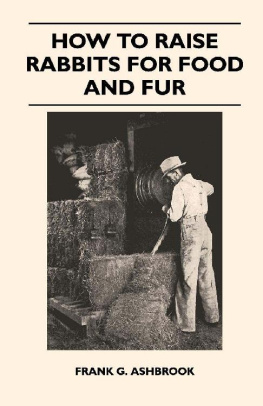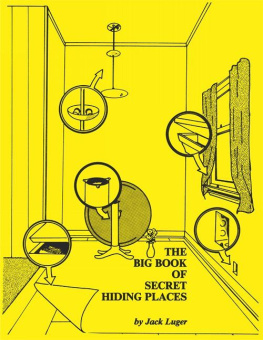
SECRET HIDING-PLACES
THE ORIGINS, HISTORIES AND DESCRIPTIONS
OF ENGLISH SECRET HIDING-PLACES USED BY
PRIESTS, CAVALIERS, JACOBITES & SMUGGLERS
By
GRANVILLE SQUIERS
Illustrated by photographs and sketches
by the Author and others
LONDON
STANLEY PAUL & CO., LTD.

INTRODUCTION
IT is now more than thirty years since Mr. Alan Fea wrote Secret Chambers and Hiding-Places, the only book which has hitherto been solely devoted to that subject. It was a remarkable compilation of patient research and inquiry, the more so because it was achieved in the days when motoring was a form of self-inflicted penance rather than a means of getting about the country.
Since those days much has been discovered about hiding-places and in many instances recorded in such publications as the Victoria County Histories, Country Life, the Reports of the Historical Monuments Commission and many other periodicals and books of which I have been able to take full advantage. I was doubly fortunate in that my profession was one which took me into almost every section of England, so that the majority of descriptions herein are given at first-hand.
One of the most interesting points about a hiding-place is the method of its construction, and this I have endeavoured to show in many cases. The accompanying sketches do not pretend to be strictly accuratemost of them are simply the artists translation of my verbal descriptionsbut if they convey the idea of how these places were made and used they do all that is required of them.
In conclusion, I must thank those many ladies and gentlemen who have permitted me to inspect their historical houses and have frequently furnished me with rare information about them. To many others, not so fortunate in their material possessions but rich in their knowledge and lore of old things, who have interested themselves in the project of this book, I also tender my heartfelt thanks. At my side are three well-filled files of their letters, in many cases crammed with details and references. Were I to mention them individually the list would be tedious. I hope I have thanked them all before, but I take this opportunity to do so again and to trust that they will consider that their kindly labours on my behalf have not been in vain.
GRANVILLE SQUIERS
Q.I.D.N.
Where the above letters occur as a footnote they stand for The Queens Institute of District Nursing. For the benefit of this organization the houses or grounds of the places so marked are occasionally open to public inspection. For the yearly list apply to The Lady Georgiana Mure, Queens Institute of District Nursing, 58 Victoria Street, S.W.I.
CONTENTS
LIST OF ILLUSTRATIONS
IN TEXT
SECRET HIDING-PLACES
CHAPTER I
TRADITION AND TRUTH
WHAT is the true test of a secret hiding-place? some sceptical person once asked the author of this book.
To that question there are four replies:
(a) Signs of obvious secrecy, such as a camouflaged entrance.
(b) Signs of furnishings or occupation.
(c) An authentic history.
(d) A good reason for a hiding-place being there.
Any of the above points may furnish sufficient evidence to quell all doubts, but to authenticate a doubtful hiding-place the reason for its existence is the most important thing to find.
Genuine secret hiding-places were always made with a definite object in view. Primitive man dug caves in the chalk and sandstone to hide from his enemies, and the medieval baron sometimes constructed an underground passage from his castle, as a means of getting food and messages through in time of siege, or as a sallyport to attack besiegers in the rear. In the days of religious or political persecutions fugitives had to conceal themselves at a moments notice, but not until the necessity arose were secret places even planned.
It is a popular supposition that hiding-places were at one time made as a regular feature whenever a house was built. Obviously, if the hiding-place was constructed at the same time as the main building, all the workmen would be aware of it. It is quite likely too that strangers roamed about buildings in course of construction in the past, just as they do at the present day, and there could be very little secrecy about a hiding-place built under such conditions. The details of construction always prove that such places were made afterwards. To this rule I have only found one possible exception, which will be mentioned in due course.
Another popular fallacy is that of the secret passage which is supposed to run from the majority of ancient buildings to some distant and improbable placegenerally a church. Curious places are occasionally found,for example, the tunnels and passages under Nottingham and Margate,but if every alleged secret tunnel in England existed this country would resemble a Gruyre cheese.
I have investigated some scores of these rumours and in the majority of cases have found them to be absolutely without foundation. When there is anything at all to be seen, it is generally a sewer or water conduit, usually the former.
Medieval mansions were often furnished with deep and wide drains, vaulted and lined with stone or brick. Sometimes these ran right underneath the houses and received the sewage through slots in the floor and carried it to the moat, river or lower level. They were frequently made tall and wide enough for a servant to go down and sweep them out periodically.
When the drainage system was improved these old sewers were sometimes bricked up, which accounts for the closed archway often seen in the cellars of ancient houses. They became forgotten in course of time, until an excavation or subsidence disclosed them and gave rise to the story of a mysterious secret passage. Before me as I write is a collection of press cuttings, garnered over a period of years, referring to finds of secret passages. In every case it is noteworthy that the passage runs in the direction of the river,for obvious reasons.
Such places are often found in the vicinity of monastic houses, for the clergy, being the only learned people in the past, realised the value of sanitation better than most. Experts on medieval architecture,in fact all good archeologists,know these tunnels well. Sewers or water conduits, whatever they may be, a reasonable explanation can always be found for them. To insist that they are secret immediately they are found is to put the cart before the horse.
The discovery of these quite unromantic passages in monastic houses by ignorant persons has given rise to many unkind stories relative to the immoral proclivities of ecclesiastics in the distant past. That many of the inhabitants of religious houses were not models of propriety is well known, but that they invariably pursued their amours underground passes belief.
Other explanations are given for the existence of mysterious tunnels. In the cases where they are said to run from manor houses to churches, we are often told that they were dug in order that the lord of the manor might go to church in secret. The fear of being seen is not an unknown mental disease, but there is no record that most of the wealthy families of the Kingdom formerly suffered from it!
Another theory is that these passages were dug as escapes for those who were pressed to take sanctuary in the churches.
This is better, but it is unlikely that the clergy would have gone to such trouble on behalf of a few persons of doubtful reputation. In any case the period of sanctuary was limited and if the offenders had been missing at the end of it there would have been awkward inquiries. It should also be noted that the exit from the place of sanctuary would hardly have been made in the residence of the lord of the manor.
Next page



